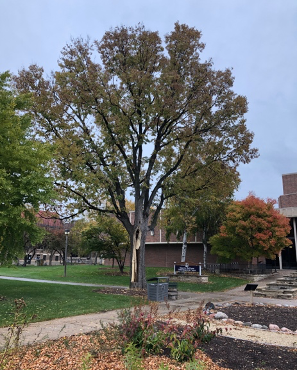Most who will read this, likely haven’t paid much attention as they walked by the Hackberry tree outside the R.A. DuFresne Performing Arts Center on WSU’s campus.
It has stood in its place and served passers-by (both human and nature’s critters alike) as a silent witness, provider, and campus benefactor for about 115 years (1905-2020). This tree is perhaps the oldest tree in the WSU campus arboretum!
However, age and a recent high-wind event on Oct. 14, 2020 resulted in a major limb being ripped from the tree revealing internal decay and the need for its removal for safety purposes.
It is appropriate that public acknowledgement be given to this century-tree whose long life served witness to over 70% of WSU’s 162-year history.

When it was a seedling in about 1905, Winona State Normal School had a total enrollment of about 604 with 24 faculty, compared to 2019-20 with about 7600 students and 465 faculty. The Normal School in 1905 was primarily a teacher training school which graduated about 139 students with 2-year teaching certificates that year, compared to today when Winona State University provides comprehensive undergraduate and graduate education producing about 1600 graduates in 2019-20 from five colleges and ninety-seven programs at the Bachelor’s, Master’s and Doctoral levels.
The physical campus in the early 1900’s consisted of one building compared to today where the main campus has about twenty-four buildings on approximately forty acres including an athletic field. This grand-old tree has served as a silent witness to the growth and development of WSU’s educational legacy!
This Hackberry tree has also served as a provider of habitat and food for birds, butterflies, squirrels, and insects, as well as of wellness opportunities for campus inhabitants. The berries produced attracted cedar waxwings and robins, the leaves provided food for caterpillars prior to them becoming butterflies, and the branches provided nesting sites for birds and squirrels to flit and scurry about as part of the campus community.
As well, the tree, along with the other trees and plants in WSU’s arboretum, provided daily opportunities for “green therapy” to campus users experiencing a host of routine forms of stress and anxiety.
Simply by taking a regular walk and being present in the moment with all of the senses alert when viewing the trees, gardens and ornamental grasses that make up the campus landscape, feelings of well-being, health, happiness and harmony can be restored. Similar thoughts are expressed by Dr. Qing Li, M.D. when he advocates the Japanese practice of “forest bathing” or “shinrin-yoku.”
Boost your happiness factor by taking a regular walk in the campus arboretum in the spring, summer and fall seasons and let the greenery surrounding you work its magic. (NOTE: During the COVID-19 pandemic, all persons on campus must complete the “COVID-19 Self-Assessment Form,” wear a cloth mask and maintain physical distance from others outdoors.)
The campus Hackberry tree (Celtis occidentalis) has also been a benefactor too! Its 73- foot height, 34-inch diameter, and 107-inch circumference has sequestered 5,236 gallons of rain and snow runoff each year.
Doing so, the tree has helped to trap pollutants like chemicals, gas, salts and litter, and reduce soil erosion during heavy rain events by storing this water in its roots, trunk, branches and leaves. Of course, improving air quality by absorbing pollutants like nitrous dioxide and sulfur dioxide, intercepting air-born particulate matter and producing oxygen through photosynthesis has benefited both the campus and community as well.
Finally, this Hackberry tree has stored 1,365 pounds of carbon dioxide in its mass per year, thus helping reduce a greenhouse gas that adds to the climate-change problem being experienced locally and world-wide. All these gifts from just one of the more that 1500 trees making up the campus arboretum!
This wonderful Hackberry tree has been a silent witness, provider and benefactor to the WSU community for more than a century. How fortunate the WSU community has been to have this grand old tree as a friend and part of the campus environment.
Authored By
- James R. Reynolds, WSU Arboretum Committee Co-Founder, Volunteer, and WSU Professor Emeritus of Sociology
- Tom Hoffmann, WSU Arboretum Committee Member
Sources
- Robert A. DuFresne, Winona State University: A History of One-Hundred and Twenty- Five Years.
- WSU Institutional Planning, Assessment & Research, “WSU Fast Facts 2019-2020.”
- National Tree Benefits Calculator
- Dr. Qing Li, Forest Bathing: How Trees Can Help You Find Health and Happiness.